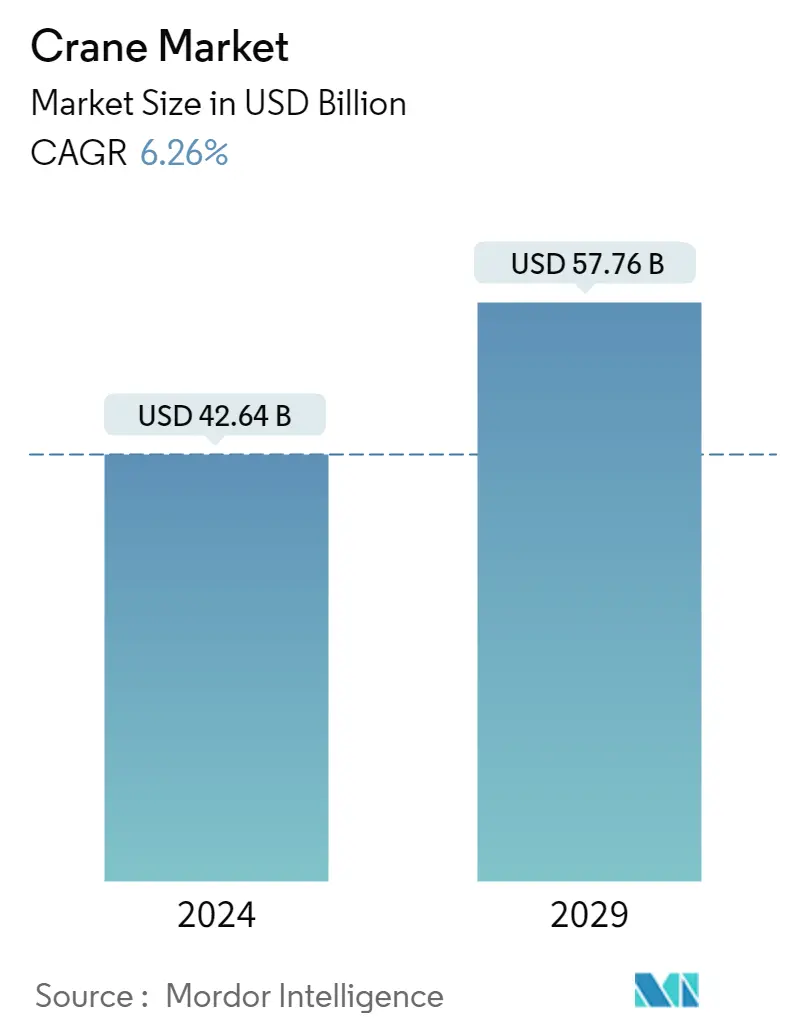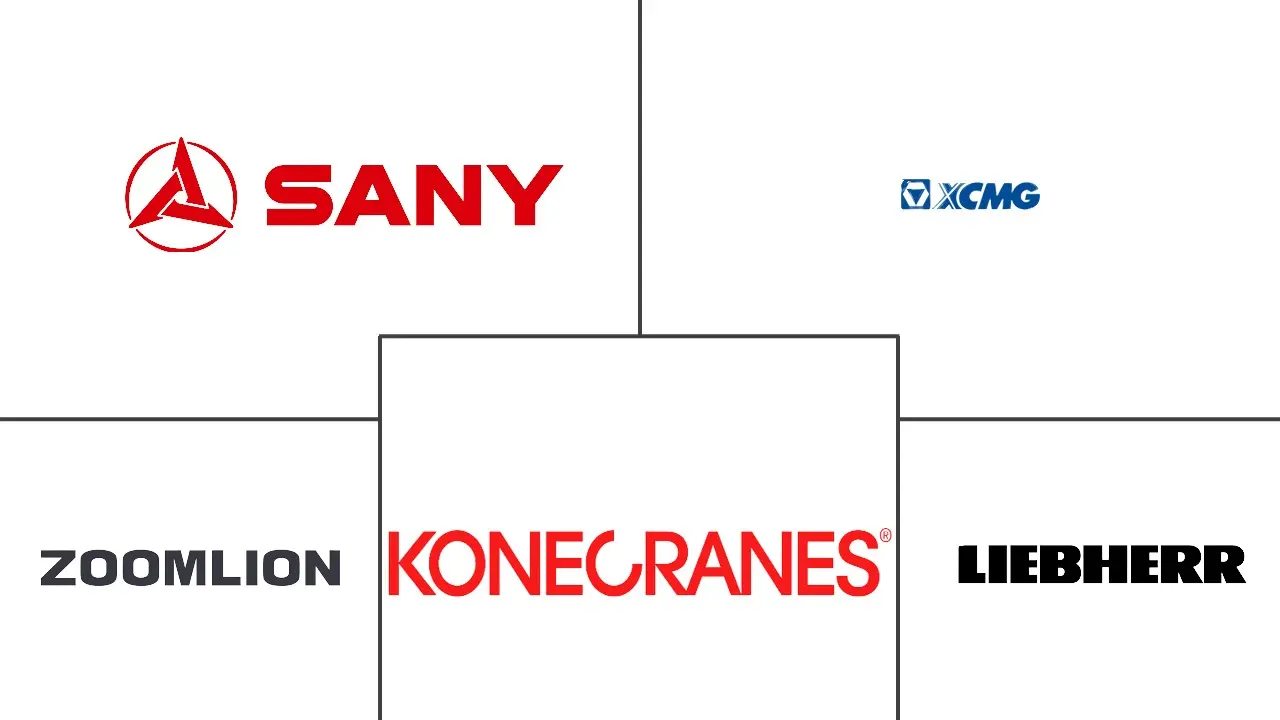Market Size of Crane Industry

| Study Period | 2019 - 2029 |
| Market Size (2024) | USD 42.64 Billion |
| Market Size (2029) | USD 57.76 Billion |
| CAGR (2024 - 2029) | 6.26 % |
| Fastest Growing Market | Asia-Pacific |
| Largest Market | Asia-Pacific |
Major Players
*Disclaimer: Major Players sorted in no particular order |
Crane Market Analysis
The Crane Market size is estimated at USD 42.64 billion in 2024, and is expected to reach USD 57.76 billion by 2029, growing at a CAGR of 6.26% during the forecast period (2024-2029).
Manufacturers are implementing contingency plans to mitigate future business uncertainties to retain continuity with clients in the critical sectors of the automobile industry.
- In 2020, Liebeherr Group focussed its R&D efforts on alternative drivetrain technologies. The Group launched the world's first battery-powered crawler cranes and the LR 1250.1 unplugged. The Group also focused on the remote production of tits cranes by remotely assembling a mobile harbor crane of the LHM 420 type in Argentina through Liebherr Remote Service App operated from Germany to mitigate the effects of the lockdown on its regular production in May 2020.
- Over the forecast period, the crane industry is expected to benefit from automated technology deployment to decrease human involvement in manufacturing facilities and offices. The fast expansion of the infrastructure and building industry to various new construction and restoration projects creates strong demand for these types of equipment.
- The crane industry is expanding due to increased government and private expenditures on new construction and development projects to offer improved infrastructural amenities. The requirement for improved structures in several industry verticals, such as telecommunications, oil and gas, and manufacturing, also supports marketing. These machines are gaining popularity in various sectors due to their superior performance and efficiency over traditional choices. The market is also anticipated to display healthy growth due to the construction of high-rise buildings like the Jeddah Tower in Saudi Arabia and the Merdeka 118 Tower in Malaysia.
- October 2022: Liebherr Group launched a new 520 EC-B crane with fiber rope. The crane has a lifting capacity of 20 ton, and its flat top design makes it versatile for many applications.
- October 2022: Manitowoc Cranes, a subsidiary of Manitowoc Company Inc., won an order for 12 Potain Igo MA 21 and three Igo 32 self-erecting cranes from Dutch crane manufacturing, sales, and rental company Montarent.
- Asia-Pacific is predicted to be the largest market for cars in the world due to the large number of high-rise buildings under construction, rapid infrastructure development, high number of ports, and presence of many crane OEMs.
Crane Industry Segmentation
A crane is a machine used to lift and move heavy loads, machines, materials, and goods for a variety of purposes. It is used in different industries, from construction to manufacturing to shipbuilding and material loading.
The crane market is segmented based on Type, Application Type, and Geography. By type, the market is segmented into mobile crane, fixed cranes, marine, and offshore cranes. Under mobile crane, the market is sub-segmented into all-terrain crane, rough terrain crane, crawler crane, truck-mounted crane, and other mobile cranes. Under fixed cranes, the market is sub-segmented into monorail and underhung, overhead track-mounted crane, and tower crane. Under marine and offshore crane, the market is sub-segmented into mobile harbor crane, fixed harbor crane, offshore, and ship crane. By application type, the market is segmented into construction, mining and excavation, marine and offshore, and industrial applications. By geography, the market is segmented into North America, Europe, Asia-Pacific, and Rest of the World. The market sizing and forecasts have been done on the basis of value (USD billion) for all the above segments.
| By Type | |||||||
| |||||||
| |||||||
|
| By Application Type | |
| Construction and Mining | |
| Marine and Offshore | |
| Industrial Applications |
| By Geography | ||||||||
| ||||||||
| ||||||||
| ||||||||
|
Crane Market Size Summary
The crane market is poised for significant growth over the forecast period, driven by increased demand in the construction and infrastructure sectors. This expansion is supported by heightened government and private investments in new construction projects, which are essential for enhancing infrastructural amenities across various industry verticals such as telecommunications, oil and gas, and manufacturing. The market is witnessing a shift towards advanced technologies, including automated systems, which are reducing human involvement in manufacturing processes. This trend is further bolstered by the rising popularity of all-terrain cranes, known for their versatility and ability to operate in challenging conditions, making them a preferred choice in the modern construction landscape.
The Asia-Pacific region is expected to lead the crane market, fueled by rapid urbanization, infrastructure development, and a surge in high-rise building projects. Countries like China and India are at the forefront, with substantial government initiatives aimed at improving infrastructure, such as the development of multi-modal logistics hubs and bullet train projects. The region's market growth is also supported by the introduction of innovative products by key players, including electric and hybrid cranes, which align with global sustainability goals. The crane market remains highly consolidated, with major players like Liebherr, Manitowoc, and XCMG dominating through strategic product launches and significant investments in research and development to meet the evolving demands of the construction, mining, and industrial sectors.
Crane Market Size - Table of Contents
-
1. MARKET DYNAMICS
-
1.1 Market Drivers
-
1.2 Market Challenges
-
1.3 Industry Attractiveness - Porter's Five Forces Analysis
-
1.3.1 Threat of New Entrants
-
1.3.2 Bargaining Power of Buyers
-
1.3.3 Bargaining Power of Suppliers
-
1.3.4 Threat of Substitute Products
-
1.3.5 Intensity of Competitive Rivalry
-
-
-
2. MARKET SEGMENTATION
-
2.1 By Type
-
2.1.1 Mobile Crane
-
2.1.1.1 All-terrain Crane
-
2.1.1.2 Rough Terrain Crane
-
2.1.1.3 Crawler Crane
-
2.1.1.4 Truck-mounted Crane
-
2.1.1.5 Other Mobile Cranes
-
-
2.1.2 Fixed Crane
-
2.1.2.1 Monorail and Underhung
-
2.1.2.2 Overhead Track-mounted Crane
-
2.1.2.3 Tower Crane
-
-
2.1.3 Marine and Offshore Crane
-
2.1.3.1 Mobile Harbor Crane
-
2.1.3.2 Fixed Harbor Crane
-
2.1.3.3 Offshore
-
2.1.3.4 Ship Crane
-
-
-
2.2 By Application Type
-
2.2.1 Construction and Mining
-
2.2.2 Marine and Offshore
-
2.2.3 Industrial Applications
-
-
2.3 By Geography
-
2.3.1 North America
-
2.3.1.1 United States
-
2.3.1.2 Canada
-
2.3.1.3 Rest of North America
-
-
2.3.2 Europe
-
2.3.2.1 Germany
-
2.3.2.2 United Kingdom
-
2.3.2.3 France
-
2.3.2.4 Rest of Europe
-
-
2.3.3 Asia-Pacific
-
2.3.3.1 China
-
2.3.3.2 Japan
-
2.3.3.3 India
-
2.3.3.4 South Korea
-
2.3.3.5 Australia
-
2.3.3.6 Rest of Asia-Pacific
-
-
2.3.4 Rest of the World
-
2.3.4.1 United Arab Emirates
-
2.3.4.2 Saudi Arabia
-
2.3.4.3 South Africa
-
2.3.4.4 Brazil
-
2.3.4.5 Other Countries
-
-
-
Crane Market Size FAQs
How big is the Crane Market?
The Crane Market size is expected to reach USD 42.64 billion in 2024 and grow at a CAGR of 6.26% to reach USD 57.76 billion by 2029.
What is the current Crane Market size?
In 2024, the Crane Market size is expected to reach USD 42.64 billion.

